Related Research Articles
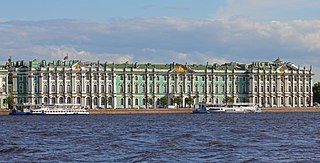
The State Hermitage Museum is a museum of art and culture in Saint Petersburg, Russia. The second-largest art museum in the world, it was founded in 1764 when Empress Catherine the Great acquired an impressive collection of paintings from the Berlin merchant Johann Ernst Gotzkowsky. The museum celebrates the anniversary of its founding each year on 7 December, Saint Catherine's Day. It has been open to the public since 1852. It attracted 4,956,524 visitors in 2019, ranking it eighth among the most visited art museums in the world.

The Museum of Egyptian Antiquities, known commonly as the Egyptian Museum or Museum of Cairo, in Cairo, Egypt, is home to an extensive collection of ancient Egyptian antiquities. It has 120,000 items, with a representative amount on display, the remainder in storerooms. Built in 1901 by the Italian construction company Garozzo-Zaffarani to a design by the French architect Marcel Dourgnon, the edifice is one of the largest museums in the region. As of March 2019, the museum is open to the public. In 2020 the museum is due to be superseded by the new Grand Egyptian Museum at Giza.

The Iraq Museum is the national museum of Iraq, a museum located in Baghdad, Iraq. It is sometimes mistakenly called the National Museum of Iraq, a recent phenomenon influenced by other nations' naming of their national museums; but The Iraq Museum's name is inspired by the name of the British Museum. The Iraq Museum contains precious relics from the Mesopotamian, Babylonian and Persian civilization. It was looted during and after the 2003 Invasion of Iraq. Despite international efforts, only some of the stolen artifacts were returned. After being closed for many years while being refurbished, and rarely open for public viewing, the museum was officially reopened in February 2015.
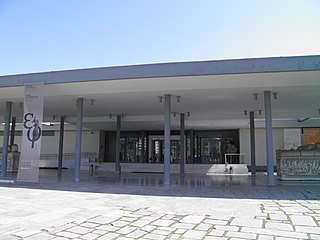
The Archaeological Museum of Thessaloniki is a museum in Thessaloniki, Central Macedonia, Greece. It holds and interprets artifacts from the Prehistoric, Archaic, Classical, Hellenistic and Roman periods, mostly from the city of Thessaloniki but also from the region of Macedonia in general.
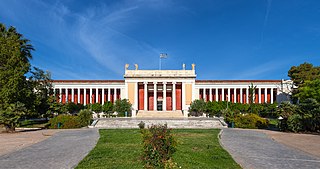
The National Archaeological Museum in Athens houses some of the most important artifacts from a variety of archaeological locations around Greece from prehistory to late antiquity. It is considered one of the greatest museums in the world and contains the richest collection of artifacts from Greek antiquity worldwide. It is situated in the Exarcheia area in central Athens between Epirus Street, Bouboulinas Street and Tositsas Street while its entrance is on the Patission Street adjacent to the historical building of the Athens Polytechnic university.
Sir John Boardman, is a classical archaeologist and art historian. He has been described as "Britain's most distinguished historian of ancient Greek art."
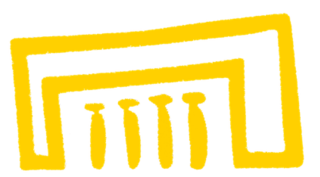
The National Museum of Beirut is the principal museum of archaeology in Lebanon. The collection begun after World War I, and the museum was officially opened in 1942. The museum has collections totaling about 100,000 objects, most of which are antiquities and medieval finds from excavations undertaken by the Directorate General of Antiquities. About 1300 artifacts are exhibited, ranging in date from prehistoric times to the medieval Mamluk period.

The National Archaeological Museum of Florence is an archaeological museum in Florence, Italy. It is located at 1 piazza Santissima Annunziata, in the Palazzo della Crocetta.

The Archaeological Museum of Chania is a museum located in the former Venetian Monastery of Saint Francis at 28 Chalidon Street, Chania, Crete, Greece. It was established in 1962.
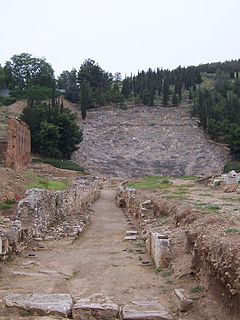
The Archaeological Museum of Argos is a museum in Argos, in Argolis on the Peloponnese peninsula, Greece. The history of the museum began in April 1932, when the heirs of J. Kallergis donated the building to the Argos city council. They in turn gave it to the Greek state along with the surrounding area on October 25, 1955.
The Distomo Archaeological Collection is a museum in Distomo, in Boeotia, Central Greece. The museum, noted for its pottery collection, was established in 1994 and is supervised by the Tenth Ephorate of Prehistoric and Classical Antiquities.

Archaeological Museum of Epidaurus is a museum in Epidaurus, in Argolis on the Peloponnese peninsula, Greece. The museum, noted for its reconstructions of temples and its columns and inscriptions, was established in 1902 and opened in 1909 to display artifacts unearthed in the ancient site of Epidaurus in the surrounding area.

The Archaeological Museum of Eretria is a museum in Eretria, in the Euboea regional unit of Central Greece.

The Archaeological Museum of Lamia is a museum within the archaeological site of Lamia Castle in Lamia, Greece. The museum is housed in a refurbished barracks built in 1830 by King Otto of Greece. It presents prehistoric and Classical antiquities, covering the Neolithic era, Helladic period, Early Iron Age, Archaic, Classical and Hellenistic periods.

The Museum of Apollonia or Fier Archaeological Museum is an archaeological museum approximately 8 km (5.0 mi) west of Fier, Albania. It was established in 1958. The museum contains artifacts unearthed nearby from the ancient Greek town of Apollonia and is close to the Ardenica Monastery.

The Archaeological Museum in Zagreb, Croatia is an archaeological museum with over 450,000 varied artifacts and monuments, gathered from various sources but mostly from Croatia and in particular from the surroundings of Zagreb.

Winifred Lamb was a British archaeologist, art historian, and museum curator who specialised in Greek, Roman, and Anatolian cultures and artefacts. The bulk of her career was spent as the honorary keeper (curator) of Greek antiquities at the University of Cambridge's Fitzwilliam Museum from 1920 to 1958, and the Fitzwilliam Museum states that she was a "generous benefactor ... raising the profile of the collections through groundbreaking research, acquisitions and publications."

The Tarquinia National Museum is an archaeological museum dedicated to the Etruscan civilization in Tarquinia, Italy. Its collection consists primarily of the artifacts which were excavated from the Necropolis of Monterozzi to the east of the city. It is housed in the Palazzo Vitelleschi.

Kırklareli Museum is a national museum in Kırklareli, Turkey, exhibiting natural history specimens, ethnographical items related to the region's history of cultural life, and archaeological artifacts found in and around the city. The director of the museum is Derya Balkan.

Aydın Archaeological Museum is in Aydın, western Turkey. Established in 1959, it contains numerous statues, tombs, columns and stone carvings from the Hellenistic, Roman, Byzantine, Seljuk and Ottoman periods, unearthed in ancient cities such as Alinda, Alabanda, Amyzon, Harpasa, Magnesia on the Maeander, Mastaura, Myus, Nisa, Orthosia, Piginda, Pygela and Tralleis. The museum also has a section devoted to ancient coin finds.
References
- 1 2 "Archaeological Museum of Chios". Chios Online. Retrieved September 14, 2009.
- 1 2 "Archaeological Museum of Chios". Chios Echo. Archived from the original on September 19, 2010. Retrieved September 14, 2009.